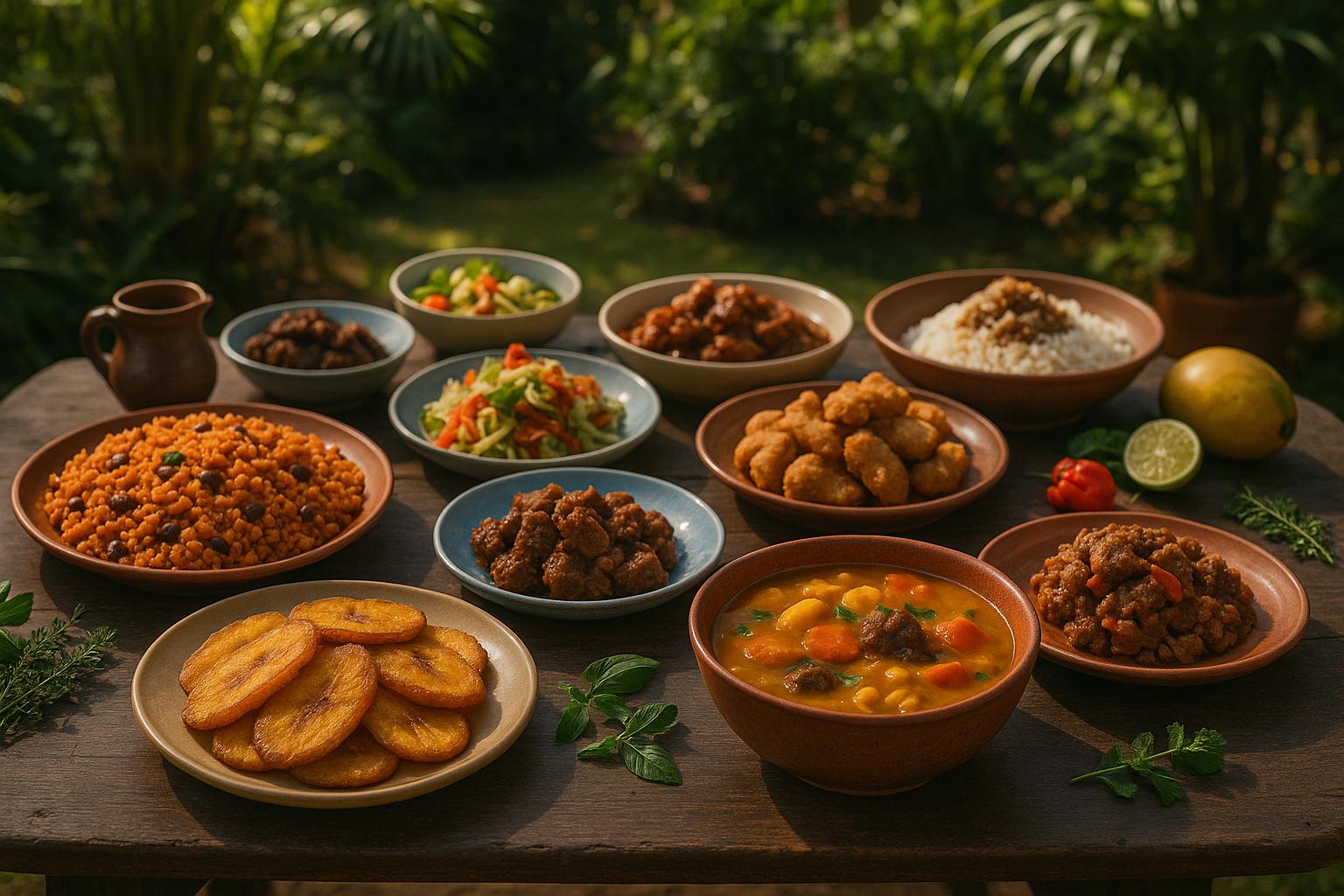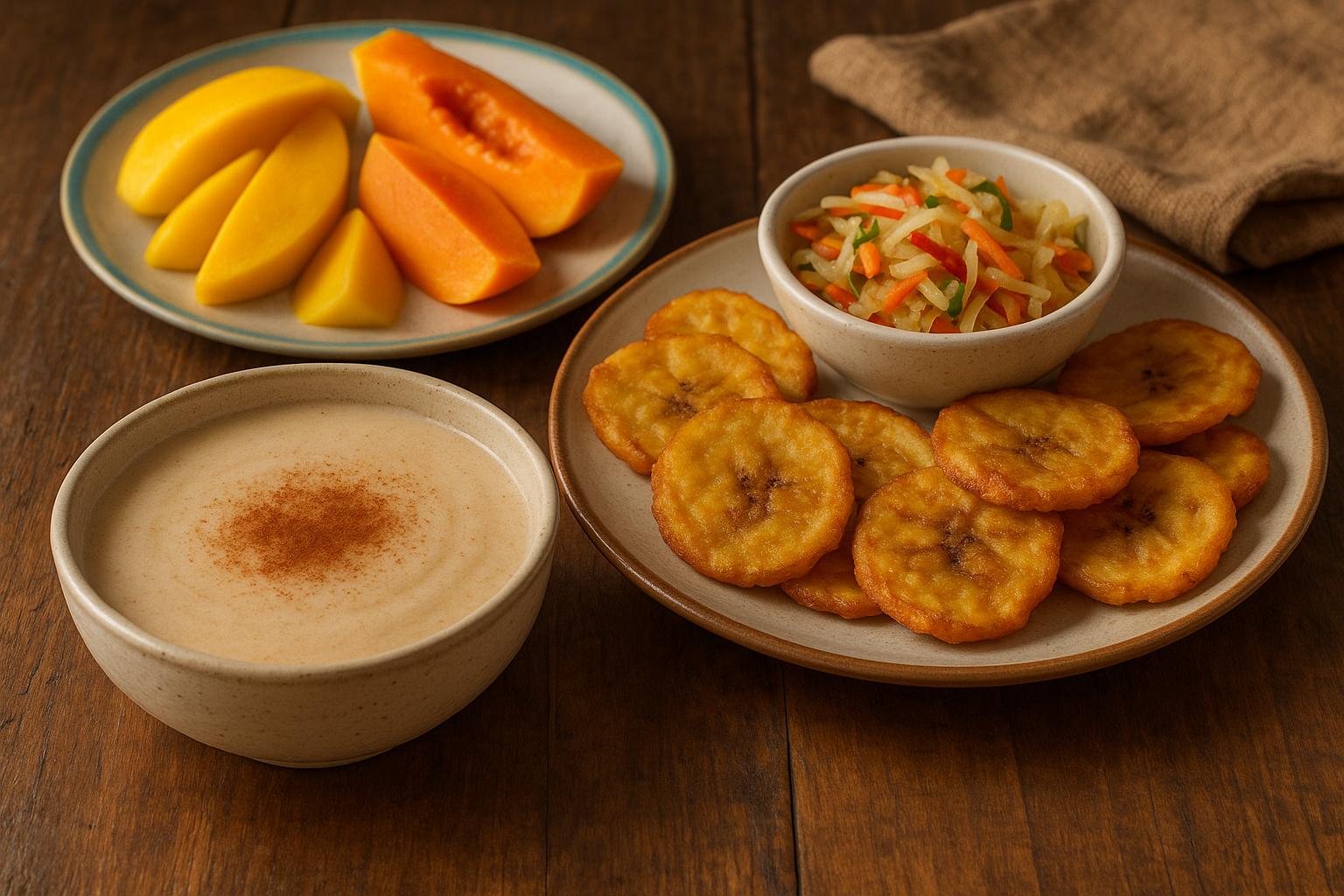Spaghetti for breakfast? Yes, it's a thing in Haiti, and it's packed with flavor and history. Haitian breakfast spaghetti is a quick, affordable, and hearty morning meal made with spaghetti, a tomato-based sauce, bold Haitian seasonings (epis), and proteins like hot dogs or sausages. This dish is a staple for many families in Haiti, offering a practical way to start the day.
Key Highlights:
- Main Ingredients: Spaghetti, tomato paste or ketchup, epis (Haitian seasoning), Scotch bonnet peppers, and proteins like hot dogs or herring.
- Origins: Introduced during the U.S. occupation of Haiti (1915–1934), blending American processed foods with local flavors.
- Why It’s Popular: Easy to cook, inexpensive, and filling - perfect for busy mornings.
Haitian breakfast spaghetti is more than just food; it’s a reflection of resilience and creativity. Whether you stick with the classic recipe or adapt it to your taste, this dish is a flavorful way to enjoy a piece of Haitian culinary heritage.
History of Haitian Breakfast Spaghetti
U.S. Impact on Haitian Food (1915-1934)
The story of Haitian breakfast spaghetti begins during the U.S. occupation of Haiti from 1915 to 1934. During this time, American military forces introduced new ingredients like dried pasta, hot dogs, and ketchup into the local diet. These additions reshaped traditional Haitian breakfasts, sparking a culinary shift that led to spaghetti becoming a staple morning dish for many families.
From Daily Meal to Family Tradition
What started as a practical and inexpensive meal option eventually turned into a cherished family tradition. Over time, traditional Haitian staples such as bulgur wheat and cassava made room for spaghetti at the breakfast table. This shift highlights the resourcefulness of Haitian cooks in blending foreign ingredients with local flavors.
Ruben Joseph, Sales and Marketing Manager at ITALA, one of Haiti's leading spaghetti manufacturers, explains the dish's popularity:
"It's easy to cook, it doesn't take a lot of money to cook, and also it's very cheap... People, when they are sending their kids to school, they can just cook one meal every morning and that's it. That's why spaghetti is the most go-to food in Haiti, after rice."
Though its origins stem from outside influences, Haitian cooks have made breakfast spaghetti uniquely their own, adding local seasonings and cooking techniques. Ann-Derrick Gaillot captures this sentiment:
"shaped by America in ways I can't always comprehend... Haitian spaghetti may not be on the menu at the new Haitian restaurant opening soon near you. But that's okay. There are those few foods that are 'comforts' - forever beloved by the people who make them."
This transformation of spaghetti from imported convenience food to a cultural staple underscores the creativity of Haitian cuisine. As Chef Stephan Durand of the Haitian Culinary Alliance puts it:
"That's just the way it is. It's a breakfast dish."
"Espageti ak Aranso" Haitian Spaghetti and Smoked Herring
Main Ingredients and Components
Haitian breakfast spaghetti stands out for its bold flavors and unique ingredients. Let’s take a closer look at the key components that bring this dish to life.
Epis Seasoning Base
Epis is the heart of Haitian cuisine, delivering a rich, layered flavor to Haitian breakfast spaghetti. As Savory Thoughts explains:
"I use epis in almost everything - rice, meats and chicken recipes, seafood, soups, stews, and even in marinades. A spoonful goes a long way. It's not just about flavor, it's about depth."
This versatile seasoning typically includes garlic, scallions, green and red bell peppers, parsley, thyme, olive oil, and lime juice. It’s a powerhouse of flavor that can be stored in an airtight container in the fridge for up to three months or frozen in small portions for even longer use.
Meat Options and Preparation
The dish offers flexibility when it comes to proteins, making it easy to adapt to different preferences. Here are some common options:
| Meat Type | Preparation Method | Notes |
|---|---|---|
| Hot Dogs | Sliced into rounds | A traditional favorite |
| Smoked Sausage | Cut into bite-sized pieces | A popular variation |
| Beef Kielbasa | Diagonal slices | A hearty alternative |
| Herring (Aronso) | Flaked | A seafood twist |
For those with dietary restrictions or preferences, the dish can also be made without meat or with plant-based alternatives, ensuring everyone at the table can enjoy it.
Adding Heat: Scotch Bonnet Peppers
Scotch bonnet peppers are key to delivering the signature heat of Haitian breakfast spaghetti. Bon Appétit highlights the importance of these peppers in Haitian cooking:
"There is much debate about what should and should not be included in epis, but there are a few fundamentals: Chopped garlic, parsley, scallions, and thyme are, hands down, a must, and bell peppers, both green and red, are found in most recipes."
To control the spice level, start with a small amount and remove the seeds and membranes, as they hold most of the heat. Add gradually, tasting as you go, since you can always increase the heat but can’t take it away. Be sure to wear gloves when handling Scotch bonnets and wash your hands thoroughly afterward to avoid irritation.
These ingredients and their preparation methods are what give Haitian breakfast spaghetti its unforgettable flavor and character.
sbb-itb-80c33ff
Step-by-Step Cooking Instructions
Ingredient Prep Guide
Getting everything ready before cooking is key to making authentic Haitian breakfast spaghetti. Here's how to prepare your ingredients:
| Component | Preparation Method | Tips |
|---|---|---|
| Hot Dogs | Boil for 3–5 minutes | Slice into rounds after boiling |
| Vegetables | Finely chop | Keep onions and peppers separate |
| Epis | Measure 2–3 tablespoons | Let it reach room temperature |
| Tomato Paste | Measure 2–3 tablespoons | Keep handy for quick use |
| Scotch Bonnet | Handle with gloves | Remove seeds to tone down the heat |
Make sure your epis (a Haitian seasoning blend) is ready ahead of time since it can be stored in the fridge for 7–10 days. This seasoning is the heart of the dish, so don’t skip it. Once everything is prepped, you're ready to start cooking.
Spaghetti Cooking Method
Cook your spaghetti just right with these steps:
- Bring a large pot of water to a boil.
- Add 1–2 tablespoons of salt to the water.
- Cook the spaghetti until it’s al dente.
- Reserve 1 cup of the pasta water before draining.
Sauce Making Steps
Now it’s time to whip up the flavorful sauce that ties the dish together:
- Start the Base Heat some oil in a large skillet over medium heat. Add the pre-cooked, sliced hot dogs and brown them lightly. Once done, remove them from the pan and set aside.
- Build the Flavors In the same pan, add the tomato paste and sauté it for 2–3 minutes until it deepens in color. Stir in the epis to release its rich aroma.
-
Complete the Sauce
Add the chopped vegetables and spices to the pan, then slowly pour in the reserved pasta water. As Food Fidelity describes:
Toss the browned hot dogs back into the pan and fold in the cooked spaghetti. Let everything simmer for 2–3 minutes so the pasta absorbs the sauce."This traditional recipe starts with a flavorful tomato sauce, which is then spiced up with a variety of herbs and spices. Scotch bonnet peppers, thyme, and garlic give it a nice kick. The whole thing is then simmered until the sauce is nice and thick."
And there you have it - Haitian breakfast spaghetti bursting with bold flavors!
Serving Methods and Recipe Changes
Standard Serving Methods
When your Haitian breakfast spaghetti is ready, pairing it with the right sides can elevate the experience. Here are some classic accompaniments that complement the dish perfectly:
| Side Dish | Purpose | Serving Style |
|---|---|---|
| Sliced Avocado | Adds creaminess and healthy fats | Served on the side |
| Hard-boiled Eggs | Provides a protein boost | Halved or quartered |
| Fresh Bread | Soaks up the sauce | Sliced and served alongside |
| Ketchup | Optional condiment | Served separately |
New Recipe Ideas
Haitian breakfast spaghetti is incredibly versatile, making it easy to adapt for various dietary needs without losing its essence. Here are some thoughtful substitutions:
| Dietary Need | Adaptation |
|---|---|
| Vegetarian | Skip the hot dogs and use sautéed mushrooms or eggplant for added texture |
| Vegan | Leave out meat and replace with vegetarian bouillon in the epis seasoning |
| Gluten-Free | Swap regular pasta for gluten-free alternatives |
| Lower Spice | Remove scotch bonnet seeds or opt for milder jalapeños |
These creative tweaks allow everyone to enjoy the dish while staying true to its roots.
U.S. Regional Variations
The versatility of Haitian breakfast spaghetti has inspired creative twists across the United States, blending its traditional flavors with local influences. For example:
- Cajun Flair: In some areas, cooks replace the usual hot dogs with spicy Cajun sausage for a bold, smoky flavor.
- Seafood Additions: Coastal regions often incorporate fresh seafood like shrimp, cod, or anchovies, adding a local touch to the dish.
These regional adaptations highlight the dish’s ability to honor its origins while appealing to a wide range of tastes.
Conclusion: Making Haitian Breakfast at Home
Bringing the flavors of Haitian breakfast spaghetti into your kitchen is a delicious way to enjoy a slice of Caribbean culinary heritage. Known for its bold and vibrant taste, this dish combines proteins, peppers, and the essential Haitian epis to create a hearty and satisfying morning meal.
Not only is this dish packed with flavor, but it's also practical - perfect for fueling a busy day. Here are some key tips to help you nail this beloved recipe:
| Key Element | What to Do |
|---|---|
| Perfect Pasta | Cook spaghetti al dente to keep it from turning mushy. |
| Sauce Consistency | Reserve some pasta water to adjust the sauce as needed. |
| Spice Control | Use whole Scotch bonnet peppers with small punctures for a balanced heat. |
| Authentic Protein | Choose hot dogs or andouille sausage to stay true to the dish's roots. |
With these simple steps, you can bring this flavorful tradition to life in your own home. Haitian breakfast spaghetti is wonderfully versatile - whether you're looking for a quick weekday meal or a relaxed weekend brunch, it’s a delicious way to celebrate Haiti’s rich culinary legacy.
FAQs
How is Haitian breakfast spaghetti different from traditional Italian spaghetti?
Haitian breakfast spaghetti sets itself apart from the Italian version with its distinctive ingredients and the way it's enjoyed. This dish features hot dogs or smoked sausages combined with tomato paste, a blend of spices, and sometimes even a touch of ketchup, creating a bold mix of sweet and savory flavors. While Italian spaghetti is usually reserved for lunch or dinner, in Haiti, this hearty meal is a cherished breakfast tradition, offering a warm and satisfying start to the day.
It’s a perfect example of the ingenuity in Haitian cooking, turning basic, everyday ingredients into a dish that feels both comforting and unique.
What role did the U.S. occupation play in the creation of Haitian breakfast spaghetti?
The U.S. occupation of Haiti from 1915 to 1934 brought unexpected additions to Haitian kitchens, including spaghetti, hot dogs, and ketchup - ingredients introduced by American soldiers. Haitians took these items and transformed them into espageti, a breakfast dish bursting with flavor. By combining these American ingredients with their own spices and cooking styles, they created something distinctly their own. Today, Haitian breakfast spaghetti remains a cherished dish, highlighting the resourcefulness and creativity that define Haitian cuisine.
Can Haitian-style spaghetti be made vegetarian or gluten-free?
If you’re looking to tweak Haitian-style spaghetti to suit vegetarian or gluten-free diets, it’s actually pretty simple. For a vegetarian twist, swap out the traditional meat ingredients like hot dogs for plant-based alternatives such as vegan sausages or seitan. They still pack in plenty of flavor and keep the dish satisfying.
For a gluten-free version, just use gluten-free spaghetti, which you can find in most grocery stores these days. With these straightforward adjustments, you can still savor the bold, delicious flavors of Haitian breakfast spaghetti while meeting your dietary preferences.


